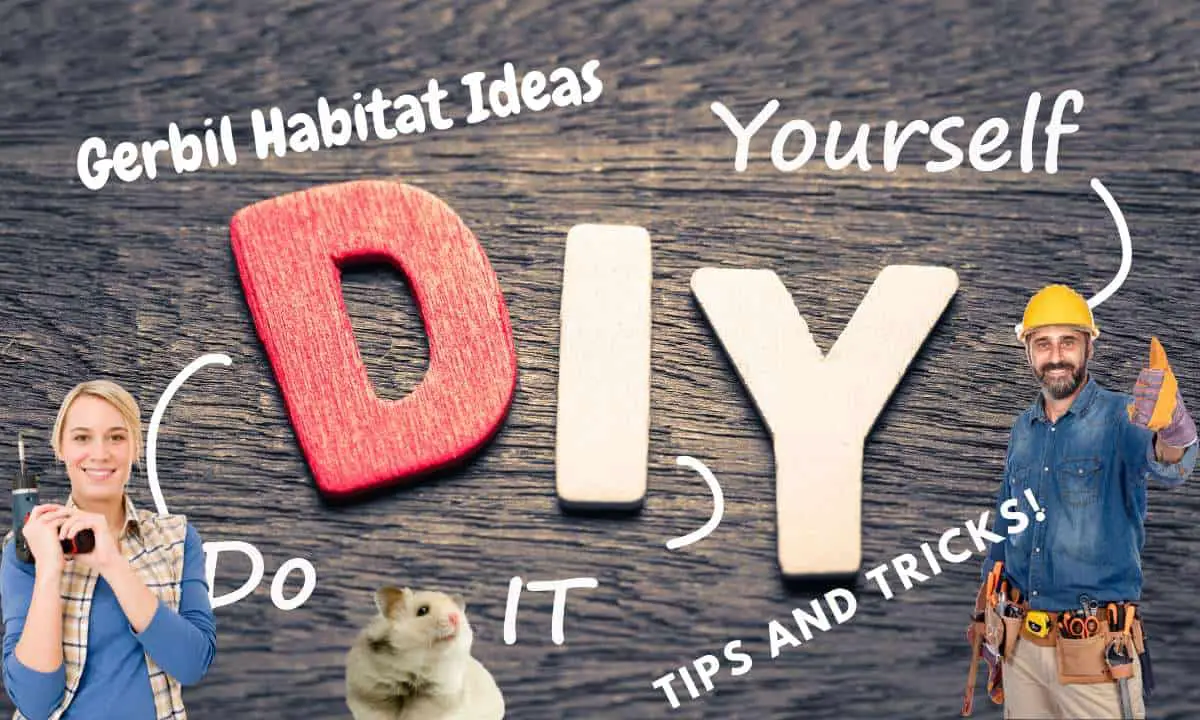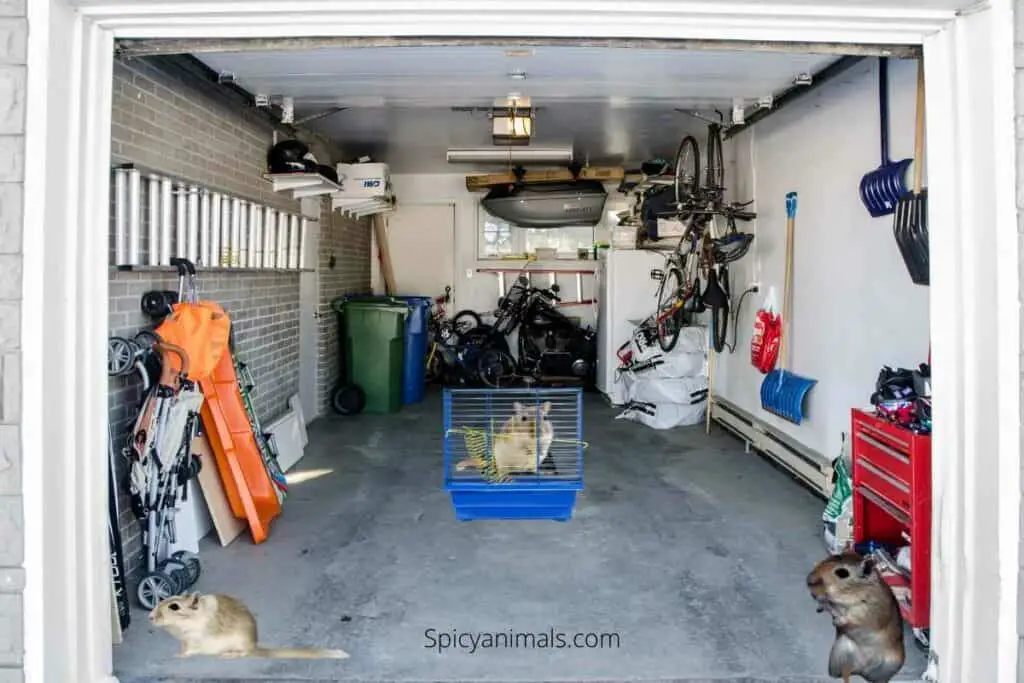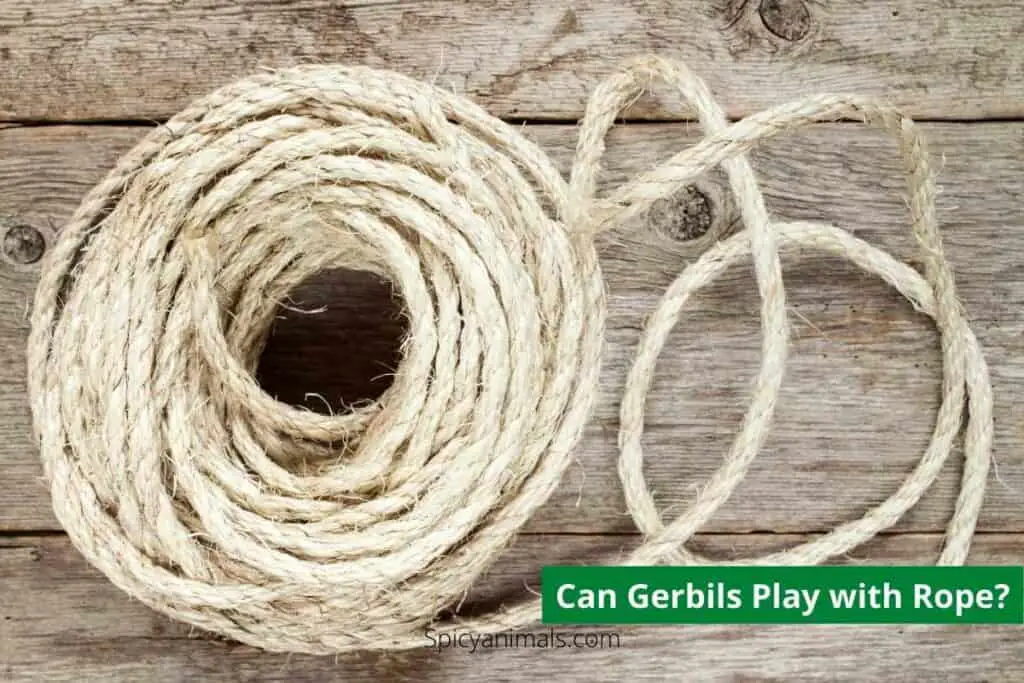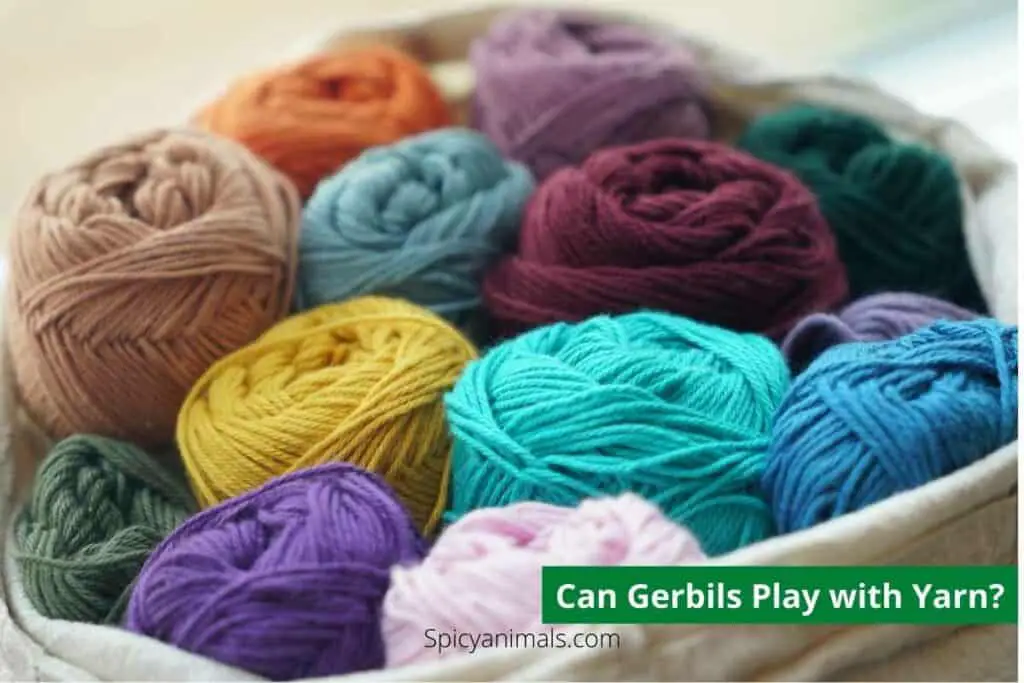Are you a gerbil owner looking to upgrade your furry friend’s living space?
Say goodbye to boring commercial cages and hello to DIY gerbil habitat ideas! In this article, we’ll provide you with creative and practical ideas for building a custom gerbil enclosure that will keep your pet happy and healthy. Get ready to unleash your inner handyman and let’s get building!
Table of Contents
Gerbil Housing Considerations
When it comes to providing your gerbil with the best possible living conditions, the type of housing you choose is essential. There are several different options available, each with its own pros and cons. Let’s explore them!
Wire Cages
Wire cages are the most popular option for gerbil owners. They offer great ventilation and easy cleaning, but some people worry about their gerbils getting their little toes stuck in the wires.
Glass Aquariums
Glass aquariums are perfect for gerbils who love to dig, as they can be filled with plenty of substrates. However, they don’t provide the best ventilation and can be quite heavy to clean.
Plastic Bins
Plastic bins are a cheap and easy option and can be great for gerbils who are prone to escaping. They’re pretty much escape-proof, but they might not be the most visually appealing option and don’t offer great ventilation either.
Now that you know the pros and cons of each option, let’s discuss how to choose the best one! Consider your gerbil’s personality and habits, their need for exercise and chewing, and their natural behaviors like digging and burrowing.
Think about the size of the habitat – the general rule of thumb is at least 10 gallons of space per gerbil. Finally, consider your own preferences and budget.
With all these factors in mind, you can create a unique and stimulating living space for your gerbil. Whether you go with a wire cage, glass aquarium, or plastic bin, make sure it’s the best fit for your gerbil’s needs!
And remember, a happy and healthy gerbil is a joy to have as a pet!!

Materials Safety
When building a DIY gerbil habitat, materials safety is crucial for your furry friend’s well-being. While it may be tempting to use any old material lying around, it’s important to make sure that whatever you use is safe.
Unsafe materials can cause health issues for your gerbil, and that’s something we want to avoid at all costs.
Here are some tips for selecting safe materials for your gerbil habitat. First, avoid using materials that are toxic or easily chewable, such as lead, zinc, brass, treated wood, or wires that can be easily chewed.
Safe options include sturdy materials like untreated wood, plastic, or glass.
Remember, your gerbil will be spending a lot of time in their habitat, so make sure the materials you use won’t harm them. Loose bedding or materials that can be swallowed pose a choking or intestinal blockage risk.
Pine, cedar, or paper-based bedding can be harmful to gerbils, so choose bedding specifically made for small animals.
In the end, your gerbils’ safety is your top priority. Use safe and sturdy materials like untreated wood, glass, or plastic to create a functional and safe habitat. Always do your research and double-check the materials you use before building your gerbil’s home sweet home.
DIY Gerbil Habitat Ideas
Multi-Level Habitat
If you’re looking for a way to spice up your gerbil’s living space, a multi-level gerbil habitat may be just what you need! This fun DIY project not only provides your furry friends with more room to play and explore but also helps stimulate their minds and keep them happy and healthy.
To create your own multi-level gerbil habitat, start by selecting a sturdy base, such as a plastic storage bin or an aquarium tank. Ensure proper ventilation by carefully drilling holes into the sides of the container and installing wire mesh panels over them to keep your gerbils safe and secure.
Next, it’s time to get creative with your multi-level design! We recommend using sturdy shelf units, such as wooden or metal ones, for each level.
Connect these shelves with ramps or ladders to provide easy access between floors. Add plenty of bedding for burrowing and resting, such as shredded paper or wood shavings.
When selecting the size and placement of water bottles and dishes, consider the size and number of your gerbils. Always provide enough water and food sources for all inhabitants to avoid competition or bullying. Opt for durable, chew-proof water bottles and dishes that won’t break easily or create a mess.
Finally, don’t forget to add toys and enrichment items to keep your gerbils entertained and happy. Consider including tunnels, wheels, and chewing blocks for them to play with and chew on.
For a natural touch, you can also add tunnels made of cardboard or wood, or even a small dirt mound for digging.
Creating a multi-level gerbil habitat is a great way to provide your furry friends with the space and stimulation they need to thrive. With a little creativity and some basic DIY skills, you can create a unique and personalized habitat that both you and your gerbils will love.
So, what are you waiting for? Get started on your own DIY gerbil habitat today!
Tunnel Habitat
A tunnel habitat is a fantastic way to provide your gerbils with a fun and stimulating living environment. To create a tunnel habitat, first, select a plastic container that is big enough to house your gerbils comfortably. Then, drill holes in the sides of the container, and insert clear plastic tubing or pipes.
The tubing should be sturdy and wide enough for your gerbils to crawl through easily. The length and complexity of the tunnels can vary, depending on your preferences and your gerbils’ personalities.
For example, more adventurous gerbils may enjoy intricate tunnel designs, while shy or introverted gerbils may prefer simpler tunnels.
When selecting tubing or pipes for your tunnel habitat, choose durable materials that are free of sharp edges. Clear tubing or pipes are usually the best option, as they allow you to observe your gerbils as they play and explore. To ensure that the pipes do not become clogged or blocked, use a vacuum hose or a pipe cleaning brush to keep them clean.
In terms of toys and enrichment items, gerbils love items that are safe to gnaw on, such as wooden chews, cardboard tubes, and untreated branches. They also enjoy tunnels and hideaways made of various materials, like woven grass, coconut fiber, and cardboard.
Gerbils are active animals, so it’s essential to provide them with plenty of opportunities to climb, jump, and explore. Small hammocks or ladders can also be added to the habitat to provide additional stimulation and fun.
Overall, a tunnel habitat can be a fun and exciting way to house your gerbils while also giving them the stimulation and enrichment they need to thrive. By following these simple steps, you can create a beautiful and long-lasting habitat that your gerbils will love.
Just remember to choose safe materials, keep the tunnels clean, and provide plenty of toys and enrichment items to keep your gerbils engaged and entertained.
A Natural Habitat for Gerbils
Gerbils are lively and adorable creatures that require a natural habitat mimicking their natural settings to thrive. The creation of such a habitat requires proper planning and close attention to detail.
Firstly, prepare a large, sturdy (ideally glass) aquarium with an adequate ventilation system. Fill the bottom with 3-4 inches of bedding material such as Aspen shavings or recycled paper bedding. This will provide a cozy and comfortable sleeping area for your gerbils.
The next step is to add appropriate accessories such as rocks, logs, and plants. These can be found at your local pet store or outside.
Large rocks will serve as a foundation for your gerbil to climb upon, while small rocks provide texture and variation in the habitat. Logs provide shelter, hiding spaces, and chewing opportunities.
Provide plants to add greenery, and hideouts, and provide a natural feel to the environment. Be sure to choose plants that are safe for your gerbils, such as the spider plant or wheatgrass. Avoid pine and cedar plants that can be harmful.
Furthermore, ensure that water dishes and food bowls are suitable for gerbils. Shallow dishes are best to avoid drowning, and heavy bowls or dishes with a firm base will prevent unintentional spills.
Be sure to choose ceramic over plastic dishes due to their durability and the ability to clean them. Keep in mind that gerbils prefer to keep their food separate from their waste, so it would be wise to have separate dishes for both.
Finally, make sure to clean your gerbils’ habitat and accessories consistently. This will keep the habitat healthy and safe for your furry friends. A healthy habitat will ensure your gerbils are happy and active, and you’ll enjoy watching them explore and play in their new environment.
Do it yourself Gerbil Toys
Gerbils are cute and playful pets that love to have fun and explore. Keeping them healthy and happy means providing them with exciting toys and enrichment items.
With a little creativity and some simple materials, you can make some fantastic DIY gerbil toys that your furry friend will enjoy. Here are a few ideas to get you started:
Digging Box
Gerbils love to burrow and dig, so a digging box is a perfect DIY toy for them. Find a shallow plastic container, fill it with organic soil, and add a few gerbil-friendly plants, such as cat grass, wheatgrass, or alfalfa. This will create an indoor garden that your gerbil can play in.
Cardboard Tube Tunnel
Cut a few paper towels or toilet paper tubes into different lengths and attach them together using non-toxic glue. You can also make a more elaborate maze out of the tubes for even more fun.
Wooden Hideout
Create a simple wooden hideout for your gerbil using a small piece of untreated wood, like balsa or birch. Cut a hole big enough for your gerbil to enter and exit easily and add some twine for them to chew and climb.
When making DIY gerbil toys, it’s essential to choose appropriate materials. Avoid using anything that might be harmful to your pet, like sharp or small parts that could be swallowed. Instead, use natural, non-toxic materials that your gerbil can safely gnaw and chew on.
In summary, creating DIY gerbil toys and enrichment items is a fun and creative way to keep your gerbil happy and stimulated. Remember to choose safe and non-toxic materials and design toys that cater to your pet’s natural instincts, such as their love for burrowing, climbing, and gnawing.
With a little imagination and some basic supplies, you can create a variety of toys and activities that will keep your gerbil healthy and entertained.
Cleaning and Maintenance
Keeping your gerbil habitat clean and well-maintained is crucial for the health and happiness of your furry friends. Whether you have a DIY gerbil habitat or a store-bought one, it’s important to follow these tips for proper cleaning and maintenance:
Supplies and Tools
Before you start cleaning your gerbil’s habitat, make sure you have the necessary supplies and tools on hand. These may include:
- Broom and dustpan
- Vacuum cleaner
- Cleaning solution
- Wipes or cloths
Spot Cleaning
For daily cleaning, use a broom or vacuum cleaner to remove any loose debris, such as droppings or scattered bedding. This should be done at least once a day to prevent the spread of germs and bacteria.
Deep Cleaning
For deeper cleaning, remove all the bedding, toys, and accessories from the habitat and scrub it down with a mild cleaning solution. Rinse everything thoroughly and allow it to dry completely before adding new bedding and accessories.
Proper Ventilation
Gerbils require fresh air and good airflow to thrive. Provide adequate ventilation in your gerbil habitat by adding an air vent or window or using a fan to circulate air throughout the space. Avoid overcrowding your gerbils, as this can reduce air quality and increase the risk of health issues.
Common Health Issues
Make sure you provide your gerbils with a healthy diet that includes fresh fruits and vegetables, along with specialized gerbil food. Look out for signs of illness, such as lethargy, loss of appetite, or diarrhea. If you notice any of these symptoms, consult a veterinarian immediately to get your gerbils the treatment they need.
In summary, cleaning and maintaining your gerbil habitat is essential for your gerbils’ health and happiness.
By following these tips and guidelines, you can create a safe and comfortable home for your furry friends that will keep them happy and healthy for years to come.
Remember to avoid using materials in your gerbil habitat that may pose a danger to your pet, such as those with sharp or small parts that could be swallowed. It’s best to use natural, non-toxic materials that your gerbil can safely gnaw and chew on, such as cardboard rolls or edible items.
Conclusion
In conclusion, building a custom DIY gerbil habitat offers numerous benefits for gerbil owners looking to upgrade their furry friend’s living space.
With the right materials and considerations, you can create a unique and stimulating living space for your gerbil that will keep them happy and healthy.
We discussed the different options available for gerbil housing and how to choose the best one, as well as the importance of materials safety and proper cleaning and maintenance.
We also provided some creative and practical DIY gerbils habitat ideas, such as a multi-level habitat, tunnel habitat, and a natural habitat, along with DIY gerbil toys that cater to their natural instincts.
We encourage readers to share their DIY gerbil habitat creations with the community and continue to provide their furry friends with the best possible living conditions.
FAQ
Will gerbils chew through a wooden cage?
Yes, gerbils are capable of chewing through wooden cages. Even the most solid wood is not safe from their gnawing. Gerbils like to chew on wood and other natural materials, so it is important to provide them with safe and appropriate chew toys.
Can gerbils live in a fish tank?
Yes, gerbils can live in a fish tank. In fact, a 20-gallon fish tank is a great home for many gerbils. However, it is important to note that the tank should not be rounded, as gerbils like to curl up in corners. Some sources recommend using a glass aquarium tank as a gerbil cage, while others caution against it due to the risk of glass shards if the gerbils scratch at the tank. It is important to provide a safe and suitable habitat for gerbils and to choose an enclosure that is appropriate for the number of gerbils you plan to keep.



